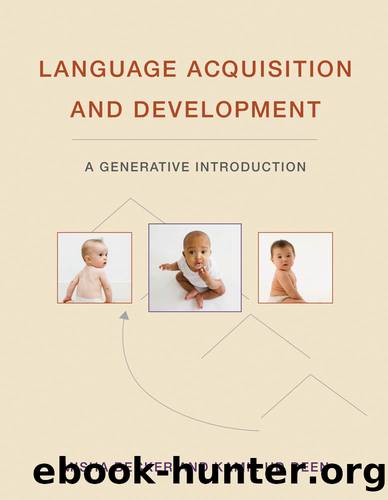Language Acquisition and Development by Misha Becker

Author:Misha Becker
Language: eng
Format: epub
Tags: Language Acquisition; Child Language; Universal Grammar; Generative; Linguistics; Syntax; Morphology; Phonetics; Phonology; Telegraphic Speech; Roger Brown; Noam Chomsky; Luigi Rizzi; Nina Hyams; Ken Wexler; Bilingualism; Language Disorders; Binding Principles; Principle A; Principle B; Principle C; Null Subjects; Truncation; Bootstrapping; Optional Infinitives; Passive Voice; Poverty of the Stimulus; Logical Problem of Language Acquisition; Developmental Problem of Language Acquisition; Specific Language Impairment; Autism; Critical Period; Experimental Methods; IPA; Negation; Questions; Relative Clauses; Induction; Continuity; Statistical Tracking; Constructivism; Speech Perception; Voice Onset Time; Speech segmentation; Stress; Rhythm; Prosody; Phonotactics; Pre-vocal speech; Phoneme; Substitution; Assimilation; constraints; Vocabulary spurt; Underextension; Overextension; Fast Mapping; Ostension; Gavagai; Whole Object Assumption; Principle of Mutual Exclusivity; Mean Length of Utterance; MLU; Suffix; Prefix; Wug Test; Overregularization; U-Shaped Development; Errors of Omission; Errors of Commission; Functional Structure; Optional Infinitive; Root Infinitive; Truncation Hypothesis; Feral children; Genie; Chelsea; Deaf Children; ASL; Blind Children; Specific Language Impairment; SLI; Hemispherectomy; Simultaneous Bilingualism; Single System Hypothesis; Separate System Hypothesis; Interdependent Systems Hypothesis; Successive Bilingualism; Language Attrition; Heritage Language; Endangered Languages; Language Revitalization
Publisher: MIT Press
student-IPM-NOM
child-DAT-EPM
money-ACC
give-PST-DECL
â âStudents each gave the children money.â
Kim et al. found that in a corpus of speech, the EPM is virtually nonexistent. They then tested twenty Korean children aged 5;3â6;9 (mean 6;1) using a Truth Value Judgment Task (see appendix B) and found that all the children failed to show knowledge of the distributive requirement of EPM. This is not surprising, given the near-absence of tokens in the input. But this raises an important question: If the EPM is so rare that children aged 6 years have not yet acquired it, how could they ever acquire this morpheme? How many tokens do they need to acquire EPM?
Kim et al. then exposed children to scenarios involving interaction between a mother and child in which the distributive meaning was exemplified, and the children were then retested for knowledge of EPM. They found that fourteen of the twenty children acquired the distributive meaning of EPM after just one exposure to EPM. A subsequent testing two weeks later showed that all fourteen of the children retained knowledge that EPM carries a distributive function.
This shows that the amount of exposure required to acquire some properties of morphosyntax need not be largeâas little as a single, meaningful exposure is enough for children to acquire some aspects of morphosyntax. Kim et al. refer to this as syntactic fast mapping, akin to lexical fast mapping (see chapter 5), since just one exposure is sufficient to produce long-lasting knowledge of the properties of EPM in Korean.
Download
This site does not store any files on its server. We only index and link to content provided by other sites. Please contact the content providers to delete copyright contents if any and email us, we'll remove relevant links or contents immediately.
| Automotive | Engineering |
| Transportation |
Whiskies Galore by Ian Buxton(41940)
Introduction to Aircraft Design (Cambridge Aerospace Series) by John P. Fielding(33093)
Small Unmanned Fixed-wing Aircraft Design by Andrew J. Keane Andras Sobester James P. Scanlan & András Sóbester & James P. Scanlan(32764)
Craft Beer for the Homebrewer by Michael Agnew(18198)
Turbulence by E. J. Noyes(7980)
The Complete Stick Figure Physics Tutorials by Allen Sarah(7338)
Kaplan MCAT General Chemistry Review by Kaplan(6902)
The Thirst by Nesbo Jo(6881)
Bad Blood by John Carreyrou(6583)
Modelling of Convective Heat and Mass Transfer in Rotating Flows by Igor V. Shevchuk(6406)
Learning SQL by Alan Beaulieu(6237)
Weapons of Math Destruction by Cathy O'Neil(6219)
Man-made Catastrophes and Risk Information Concealment by Dmitry Chernov & Didier Sornette(5957)
Digital Minimalism by Cal Newport;(5704)
Life 3.0: Being Human in the Age of Artificial Intelligence by Tegmark Max(5516)
iGen by Jean M. Twenge(5386)
Secrets of Antigravity Propulsion: Tesla, UFOs, and Classified Aerospace Technology by Ph.D. Paul A. Laviolette(5333)
Design of Trajectory Optimization Approach for Space Maneuver Vehicle Skip Entry Problems by Runqi Chai & Al Savvaris & Antonios Tsourdos & Senchun Chai(5037)
Pale Blue Dot by Carl Sagan(4957)
